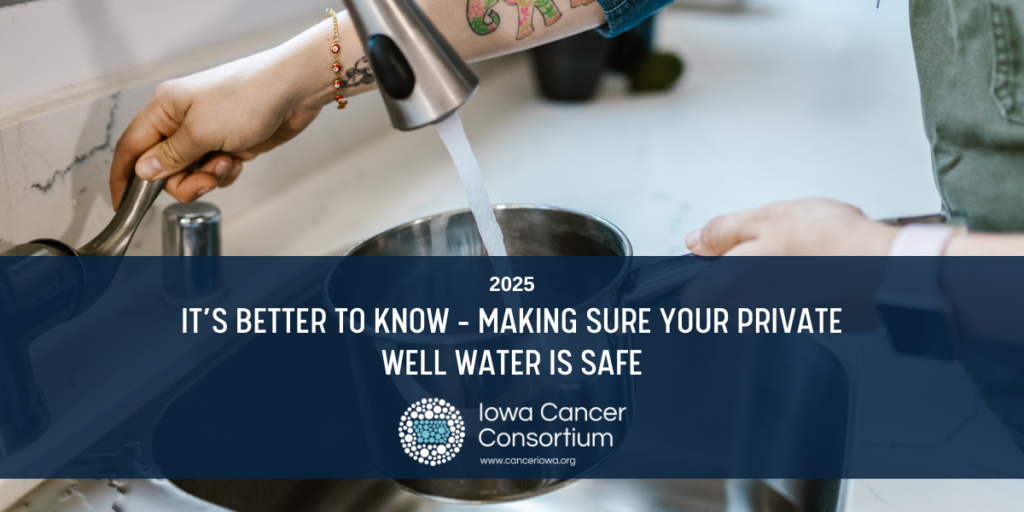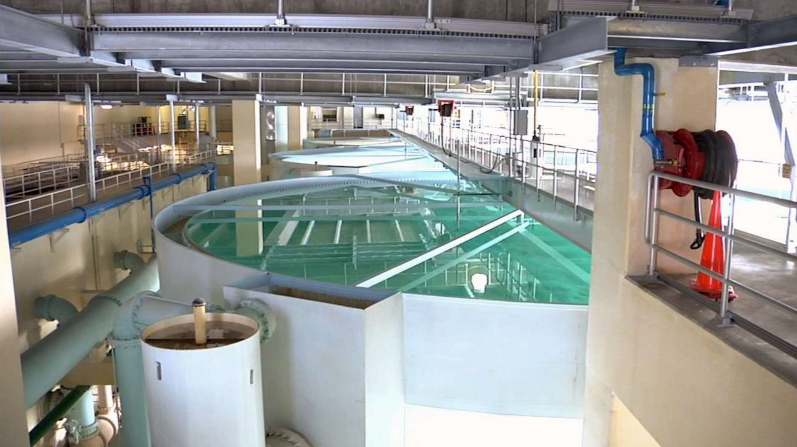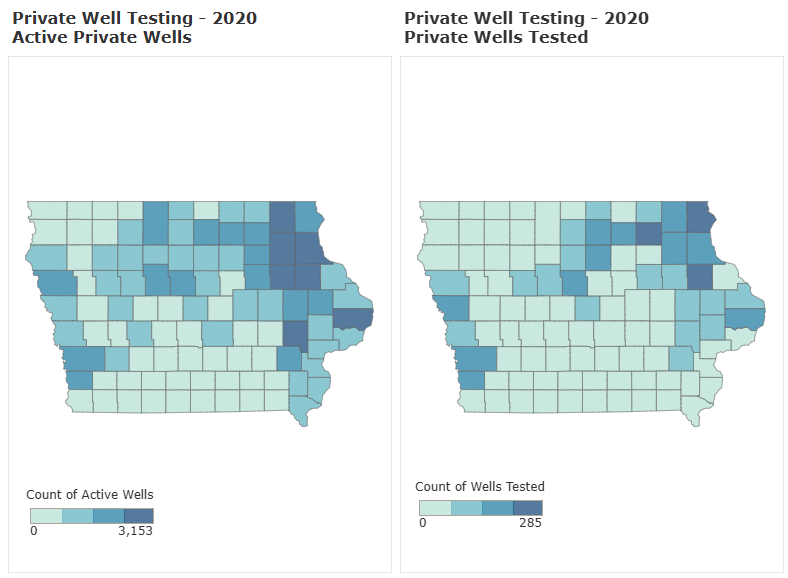It’s better to know – Making sure your private well water is safe

By Catherine DeLong, Water Quality Program Manager with Iowa State University Extension and Outreach
Spring in Iowa is a great time to watch the Redbud Trees bloom, listen to the hypnotic sound of frogs – and if you’re a private well owner – test your drinking water quality.
The #1 responsibility of the 230,000 Iowans who rely on private wells as a drinking water source is to test their water quality every year. This is important because the day-to-day water quality of private wells is unregulated; meaning that it is up to the owner of that well to ensure the water is safe to drink. According to the Iowa Department of Health and Human Services, pollutants like bacteria, arsenic and nitrate are found at elevated levels in 10-29% of private wells in Iowa, and exposure to elevated levels of some pollutants has been linked to cancer.
Public vs. private water sources
The majority of Iowans, about 93%, get their drinking water from public water sources like the Des Moines Water Works or Rathbun Regional Water Association. These public utilities, rural water associations, mobile home parks and other systems that regularly serve 25 or more individuals, are regulated under the federal Safe Drinking Water Act. This means that they must maintain specific water quality standards set at the federal level. If they ever violate any of these standards, they are required to report it to the public.

Iowa City water treatment facility. Photo courtesy Iowa City Water Division.
Information about violations is compiled annually into a report by the Iowa Department of Natural Resources. Another great resource is “Iowa Trust Your Tap” which is maintained by the Center for Health Effects of Environmental Contamination at the University of Iowa. It is an easy-to-use website that allows you to look up your local water utility or rural water association to understand if it has had any violations in the past decade.
In 2023 in Iowa, the percentage of public water systems in compliance with all health-based standards was 97%. The most common violations were for nitrate-nitrogen followed by arsenic. We’ll talk about the health effects of nitrate and arsenic a little later.
According to the Environmental Protection Agency, Iowa consistently ranks in the top ten states for the least amount of health-based drinking water quality violations. This high quality is thanks to the hard work of the operators, technicians, and engineers who clean our water and maintain water utilities. These essential workers make sure that the water that comes out of our tap is clean 24 hours a day and 365 days per year.
Private wells are on the opposite end of the regulatory spectrum; the only way to know if the water is safe to drink is for individuals to test the water.
Private well water quality should be tested every year
The Centers for Disease Control and Prevention, Environmental Protection Agency, Iowa Department of Health and Human Services, and Iowa State University Extension and Outreach all recommend that private well owners test their well water quality annually.

In 2020, Iowa HHS reposted there were 96,497 active private wells. Of those, only 6,310 were tested. View interactive maps from Iowa HHS.
The most common issue in private wells is bacteria; in 2020 total coliform bacteria was found in 29% of Iowa wells. Coliform bacteria is a large group of bacteria that can come from many sources including humans, animals and the environment. It is generally harmless, but can cause mild gastrointestinal distress. Coliform bacteria does, however, indicate that there is some sort of sanitary defect in the well and the water should be tested for more harmful forms of bacteria such as fecal coliform and E.coli. Arsenic was found in 14% and nitrate in 10% of Iowa wells above the drinking water standard. We’ll focus our discussion on the pollutants that have links to cancer, arsenic and nitrate, and include PFAS or per- and polyfluoroalkyl substances and radon, which are not routinely found in wells, but are a concern for many Iowans.
Arsenic and private well drinking water
Arsenic, and in particular inorganic arsenic, is a human carcinogen with specific links to lung, bladder, kidney, skin and liver cancers. Many factors contribute to the extent of negative impacts including the amount and duration of exposure, as well as individual genetic background.
Arsenic occurs naturally in the environment and can also be a byproduct of various agricultural and industrial processes such as wood treating or lead smelting. Inorganic arsenic was, at one time, a common ingredient in pesticides, but has not been used in the US since 1993.
One natural source of arsenic in Iowa is the Lime Creek Aquifer. Aquifers are permeable rock that hold groundwater. We learned about this source of arsenic in private wells thanks to the detective work of Cerro Gordo County Public Health.
Arsenic is odorless, tasteless and colorless. The only way to know if it’s present in your well is to test. The maximum contaminant level, or highest allowable level of a contaminant in safe drinking water, is 0.01 mg/L for arsenic. The good news is, if you test and find that you do not have arsenic above the drinking water standard, then you do not need to test for arsenic for at least three years.
If you do have arsenic above the maximum contaminant level you should consider installing a home treatment system that removes arsenic such as reverse osmosis, distillation, activate alumina, or anionic resin. More information about home treatment systems can be found in this excellent guide from the State Hygienic Laboratory.
Nitrate and private well drinking water
Nitrate-nitrogen is the water-soluble form of nitrogen. Nitrate is not considered a carcinogen, but has been linked to increased incidence of colorectal cancer (Ward et al., 2018).
Nitrate occurs naturally in the environment but is also applied to the land as fertilizer and manure. Some of the main sources of nitrate in our drinking water are agricultural fields that lack living roots, fertilizer, septic systems and manure.
Nitrate is also odorless, tasteless and colorless and the only way to know if it’s present in your well is to test. The maximum contaminant level for nitrate is 10mg/L.
All Iowans with private wells should test for nitrate every year, as nitrate in shallow groundwater can change year to year and season to system. Shallow wells that are less than 100 feet in depth, and also wells in karst areas, are the most vulnerable to nitrate. Karst is a rock formation that is similar to swiss cheese and generally found in northeast Iowa. The rocks are made up of materials like limestone that easily dissolve forming holes. When it rains, water from the surface easily enters aquifers.
We tend to see the highest spike in nitrates in surface and shallow groundwater in the spring before corn and soybeans are actively growing on the landscape. This is why spring is a great time to test your well water, especially if you have a shallow well.
Nitrate can be removed through some home treatment systems such as reverse osmosis, distillation and anion exchange.
PFAS and private well drinking water
PFAS or per- and polyfluoroalkyl substances are a large group of lab-made chemicals. The EPA’s Scientific Advisory Board stated in a draft report that more evidence is needed to define PFAS as a carcinogen, but individual studies have found links to a wide range of cancers.
PFAS is often referred to as a ‘forever chemical’ because it persists in the environment. In the past, it was commonly used in Teflon, Scotchgard, GORE-TEX, and firefighting foams.
In April of 2024 the EPA imposed a national drinking water standard, or a maximum contaminant level, for certain PFAS substances. These PFAS substances include 4 ng/L (or 4 parts per trillion) for PFOA & PFOS and 10 ng/L for PFNA, PFHxS, GenX chemicals.
If you are near a known site for PFAS contamination, then you may be able to test your well at no charge through your county department of public or environmental health. You can review this map to see known sites for PFAS or you can ask your county’s sanitarian or private well specialist.
PFAS can be removed through some home treatment systems such as reverse osmosis, granular activated carbon and anion exchange.
Radon and private well drinking water
Radon is a gas that comes from the natural radioactive breakdown of uranium in the soil. The vast majority of radon exposure is from the air in your home, which is why it’s important to test your home for radon every 2 years, but it can also be present in groundwater. Radon in drinking water has been linked to stomach cancer.
Radon is odorless, tasteless and colorless. There is currently no federal drinking water standard for radon, but you can work with the State Hygienic Laboratory to test your water for the presence of radon. More information on testing options can be found here.
Radon in water can be removed through some home treatment systems including granular activated carbon filters and aeration devices.
How to test your private well water quality
The only way to know if your well has any of these pollutants is to test. Luckily, Iowa has a unique program called the Private Well Grants Program, that allows for free or very low-cost annual testing of private wells for bacteria, arsenic, nitrate and manganese. To access this program, the well sample must typically be taken by a county department of public/environmental health employee. You can find your county contact on this list. Reach out to them to schedule a water test, and they can also help you interpret results.

Allison Roderick, environmental health officer for Webster County, Iowa, draws a sample of well water from a home near Fort Dodge, Iowa. Photo Credit: Tony Leys/KFF Health News
To sum things up, private well owners in Iowa should test their well every year for bacteria and nitrate. Spring is a great time to test for nitrate, especially if you have a shallow well. All private well owners should test for arsenic, but if your results show that arsenic is not an issue, you do not need to test again for at least three years. PFAS and radon can be found in private wells, but are not included in the Private Well Grant Program that facilitates free testing. If you are near a known PFAS contamination site you may be able to access a free test if you work with your county’s private well specialist. You can test your water for radon, for a fee, from the State Hygienic Laboratory.
If these pollutants are in your well above the safe drinking water standard, they may not make you sick immediately, but are linked to long-term health effects including cancer.
If you’d like to learn more, consider attending the Private Well Stewardship Program offered through Iowa State University Extension and Outreach. This 1-hour educational program helps Iowans learn about the responsibilities and risks of being a private well owner and connects you to additional resources to manage your well. Reach out to your local county Extension office to request the program and explore this website to learn more.
About the Author
 Catherine DeLong is the Water Quality Program Manager for Iowa State University Extension and Outreach. She works statewide to bring people together to share resources, ideas and perspectives about water quality, and to help Iowans understand the role they can play in the future of Iowa’s water. Catherine connects researchers to practitioners and the general public and helps to translate water quality science to a broad audience. She also builds coalitions and new programs to meet current and future needs. Catherine has a background in soil science and agricultural policy and has experience at all levels of conservation, having previously worked for the county-level Soil and Water Conservation Districts as well as an international non-profit serving conservation professionals.
Catherine DeLong is the Water Quality Program Manager for Iowa State University Extension and Outreach. She works statewide to bring people together to share resources, ideas and perspectives about water quality, and to help Iowans understand the role they can play in the future of Iowa’s water. Catherine connects researchers to practitioners and the general public and helps to translate water quality science to a broad audience. She also builds coalitions and new programs to meet current and future needs. Catherine has a background in soil science and agricultural policy and has experience at all levels of conservation, having previously worked for the county-level Soil and Water Conservation Districts as well as an international non-profit serving conservation professionals.

